
Hiking Dude Blog
2025 - Aug Jul
2024 2023 2022 2021 2020 2019 2018 2017 2016 2015 2014 2013 2012 2011
09/29/2021

Have you ever planned an epic adventure and then at the last minute have something happen so it had to be cancelled? I'd love to hear about it in a comment...
This week was supposed to be an Up North Minnesota adventure on the Border Route Trail with my wife. Last year, she set an FKT on the Kekekabic Trail, so we wanted to continue along the longest of trails at 4600 miles - the North Country National Scenic Trail this fall.

Unfortunately, a summer knee injury has just taken an extra long time to heal, and I couldn't work out logistics for a solo trek, so we have to delay this adventure to next year. We can't even blame covid for this one.
I believe it's better to plan for more and settle for less. That way, you're seldom caught with nothing to do even though you will occasionally not have a plan come together - and that's just fine. I've racked up about 1000 miles of hiking in the mornings this year, so it's all good! I'm still trying to wear out my Kuhl pants and they're going strong.
Just this past week, my son told me to download Pokemon Go to my phone. I thought that was all over and done with, but I guess there are more people playing it now than when it came out 6 years ago. Anyway, I've been playing it for a week and have discovered that I walk slower but the time passes much faster. I'm up to level 25 and still haven't figured out how to raid a gym with other players. :-) Well, whatever gets you out on the trail, right?
Hike On!10/04/2021

Besides hiking a lot, I brew beer. Homebrewed beer has a lot more character than mass-produced beer, and it's usually unique, flavorful, and powerful. I just discovered that craft jerky is definitely not the same as mass-produced 'jerky', and is more like homebrew - unique and packed with flavor!
TL;DNR - I taste tested this dirty dozen bags of Righteous Felon jerky to see if the product was as good as the hype. Oh, yes! It was a rainbow of flavors, ranging from sweet, sugary, barbeque to eye-sweating chile peppers, with some detours through a plethora of herbs and spices along the way. Just go buy or steal their Righteous Sampler for yourself and get all 12 flavors - use HIKING10 promo code to knock 10% off the price, or off your jail time.
What's This About? - The righteous folks sent me a box of craft jerky to try. They do all their dirty deeds in Pennsylvania, not far from the Eastern PA State Penitentiary if that tells you anything. The claim is that small-batch, craft jerky just murders the big brand, always the same, jerky stuff that you're used to gnawing on. I've eaten plenty of jerky on my long hikes and it's pretty much just a salty snack to chew away on while putting in miles. So, I did a 12-mile hike and 20-mile bike ride this weekend, and took my sack of jerky along. I wanted to see if craft jerky is any different - my oh my, this weekend set me straight!
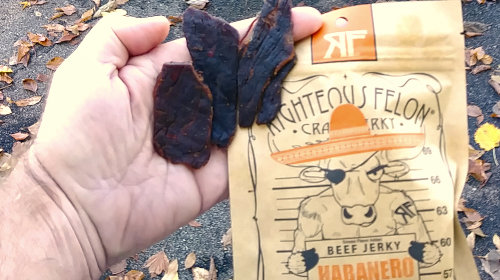
Where's the Beef? - You won't be wondering with this jerky. It's all prime cuts of American Black Angus beef raised outdoors in pastures in Texas and Maryland, and free of antibiotics and growth hormones. A cool thing about this jerky is it's just beef, lots of beef - and no unpronounceable preservatives and chemicals added. And, that means a solid protein source for hiking and other outdoor activities that challenge your body to recover from hours of muscle stress.
It's Just Jerky, Right? - Yeah, no, I thought so, too. The Righteous recipes all have that solid Beef as their main ingredient, but every recipe has its own mix that delivers a unique taste bonanza. I tried the whole dozen and have ranked them in order of my preference below. I noticed a few things about ALL the choices:
- Good Meat - some pieces were softer than others, but generally all of it had a good, healthy chew with nothing too hard or tough. Consistently good texture and a nice beefy flavor throughout.
- Flavor Over Salt - not overpowering or bland, just the right amount of saltiness letting the real flavors come through. The Maryland Monroe flavor was the only one that tasted a bit too salty for me.
- Unique Taste - the recipes made for very different tastes, each with their own style.
- Fun Names - each recipe is a play on some famous name, each having something to do with the flavor.
But, Didya Like It? - It turns out I kinda prefer hot & spicy jerky, followed by sweet & smoky, with strong herb seasoning bringing up the rear. But, there was only one that I didn't really care for: 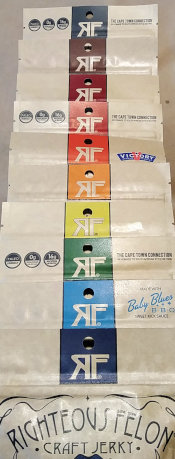
- Habanero Escobar - My absolute Fav! Habanero peppers take their time in releasing the heat as you chew this jerky. It started a bit sweet, but that was overtaken by the habanero heat after awhile. Lock this one in the vault!
- Ancho Villa - Ancho pepper heat builds as you enjoy the beefy biltong. These Mexican peppers may have been smuggled in, but I don't care.
- Voodoo Chile - What do you expect from the world's hottest chili pepper? Yeah, it's HOT!!! It started slightly sweet, but the heat exploded after chewing for awhile when it was too late do do anything about it. The back of my tongue got hot, then my throat, then everywhere. I sweated more chewing this than that time the popo interrogated me in the Big Apple.
- Bourbon Franklin - Pretty much the polar opposite of the Voodoo Chile recipe, this bourbon and vanilla bean jerky is just as much fun. I enjoyed this sweet smelling, sweet tasting jerky almost as much as conjugal visits during my time in San Quentin.
- O.G. Hickory - This is pretty much what you'd expect from a hickory smoked jerky. It tastes and feels great, but no wild taste sensation. If you're a boring white-collar criminal skimming pennies off the ledger, then this is your jerky.
- Baby Blues BBQ - From the name, I wanted it to taste like barbeque sauce but I didn't get that. A little habaneros & serranos peppers provide some heat to balance the BBQ sweetness, so it's a great choice for an illegal poker night in Minnesota when the guys want to get rowdy.
- Darth Garlic - OK, this one was pretty weird. There's no saltiness. There's no sweetness. There's no heat. Weird, huh? It smells and tastes really good, though. It's just like chewing on a moist, tender, seasoned slice of beef.
- Truffle-o Soldier - Mushroom jerky is a new one for me, but it's certainly an interesting taste treat. Opening the package, I could not identify the aroma. Chewing it, I could not identify the taste. But, a definite earthy, mushroomy aftertaste lingered around. The truffle flavor comes from contraband seized in a Pennsylvania raid and then lifted from the evidence locker by Light-finger Lefty hired by the guys at Righteous Felon - but don't tell anyone.
- Maryland Monroe - Impregnated with hickory & crab spice, this jerky tastes a whole lot like the Old Bay seasoning in the pantry at Norma Jeane's house that she uses on shrimp, salmon, crab, whatever. The celery salt is pretty powerful, making this the most salty tasting of the bunch.
- Victorious B.I.G. - This is the one flavor I was really looking forward to trying. The hype said it has some beer flavoring it, so of course my imagination took over and I was expecting a chewy chocolate stout. Alas, all I got was a great tasting, sweet jerky with a potent black pepper punch. If I was honest, instead of a scoundrel, I'd rate this higher, but I'm still bummed about missing the beer taste.
- Fowl Capone - Best Name award winner! If you like the aroma and taste of basil, corner the market on this jerky. It smells like my wife's basil plant, definitely basil tasting, somewhat sweet with lots of herbs.
- Nelson Mandilla - Obviously, this biltong was secretly transported through Righteous Felon's South African connection. It was hidden inside a cargo of fresh dill weed inside a slowboat across the Atlantic for 3 weeks. It has a powerful dill aroma, and tastes like chewing on a dill plant, not salty, not sweet, not peppery. My taste buds just didn't get along with this one.
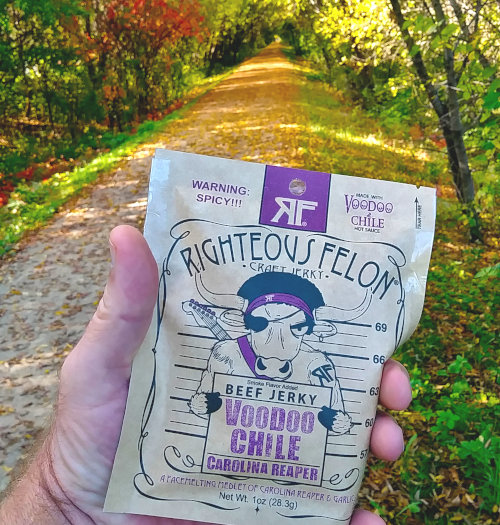
The HOT One!
Is This Legit? - You can't really trust a gang called Righteous Felon, can you? So, listen to me instead. After all, I've never been convicted of any felony:
- It's Gluten Free, except for Bourbon Franklin and Victorious B.I.G. due to the booze used in their flavoring.
- Made in USA, baby!
- High protein, and that's the whole reason for jerky anyway, 'miright?
- Simple ingredients! Here's what's in my favorite Habanero Escobar - beef, water, brown sugar, soybeans, salt, molasses, chipotle pepper, vinegar, black pepper, natural smoke flavor, alcohol, habanero peppers, garlic powder, onion powder, red pepper, paprika, cloves, chili powder.
What's the Catch? - Go to https://bit.ly/2Z5n20y and use HIKING10 for 10% off your order.
Check out Righteous Felon Jerky Cartel to wina buncha jerky fer yerself before Oct. 8 - yeah, that's this year, 2021, duh!
Pssst, Buddy, Down On Your Luck? - Righteous Felon jerky is around $44/lb which is right in the ballpark of other high-end jerkies, certainly not cheap. The mass-produced, monotonous, chemical-laden brands are half that.
If you're looking to save a bit, they have 8 ounce bulk bags of jerky that saves about 14%.
If you're feeling adventurous, they've also got Shredded Jerky Chew which is a hodgepodge of all their jerky bits thrown into a bag. You don't know what flavors you'll get, but it's just $16/lb! Perfect for a hungry hiker wanting a surprise selection of snacks. It's all good.
Finally, the cheapest option is a bag of their meatstick nubs, the ends from their meatsticks. Same good meat and taste, just bite-size pieces for $12/lb.
Biltong? Huh? - Yeah, new to me, too. Biltong is just a different way to preserve meat. It's like jerky, but air dried for many days without heat rather than with heat. It originated in southern Africa while jerky comes from South America. Now you know. Your day wasn't wasted!
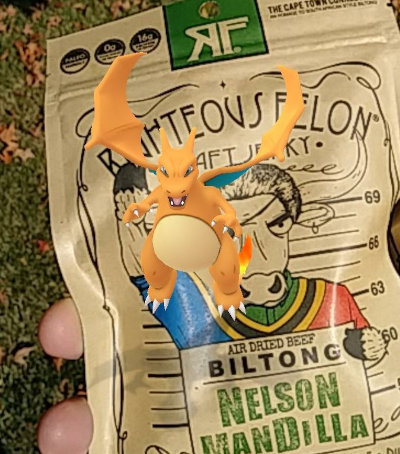
Great Pokemon GO snack - Catch 'Em All!
Posted: 10/04/2021
08/03/2022

OMG, what a hike!
I just got back from a family backpacking trip - myself, wife, two sons, and a girlfriend. Seven days of hiking and camping on the West Coast Trail of Vancouver Island, British Columbia, Canada was a wonderful week in the wilds. I finished my trip report, but wanted to share a few pictures now.
The trail has plenty of ladders...
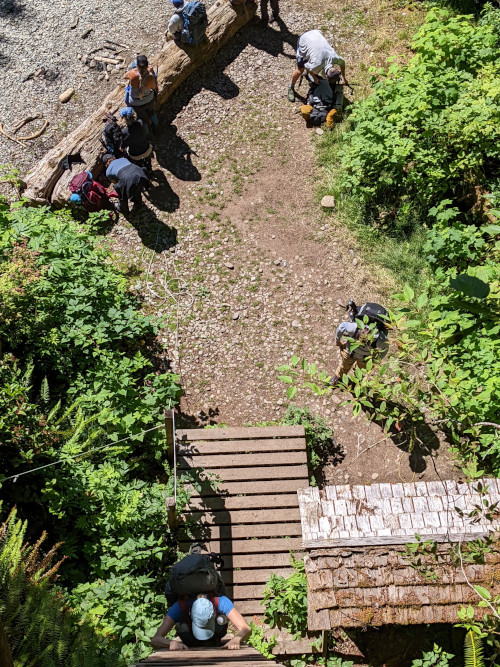
First (and steepest) Ladder right at the southern trailhead.

Ladders Going Up and Down
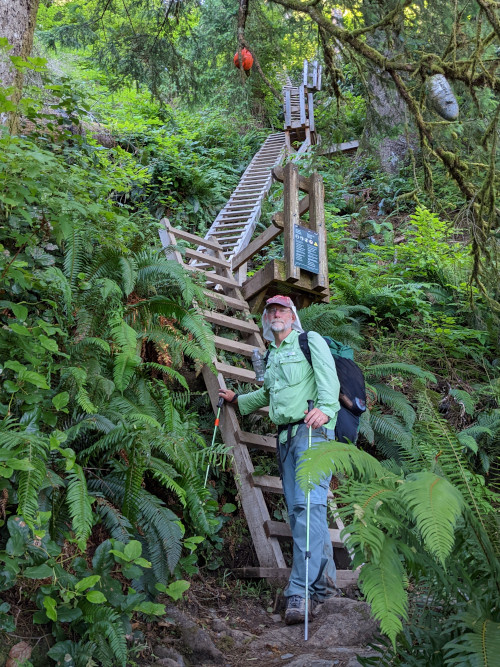
Ladders Upon Ladders
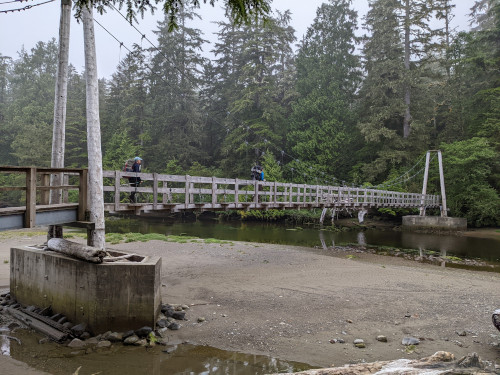
Nice Bridge Across River
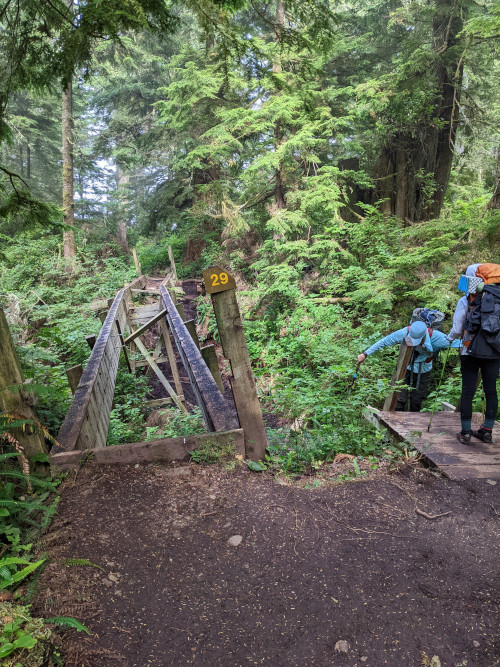
Not So Nice Bridge
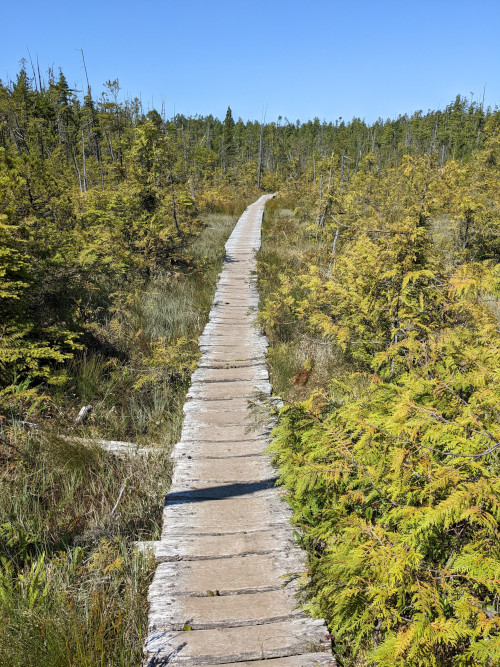
Nice Boardwalk
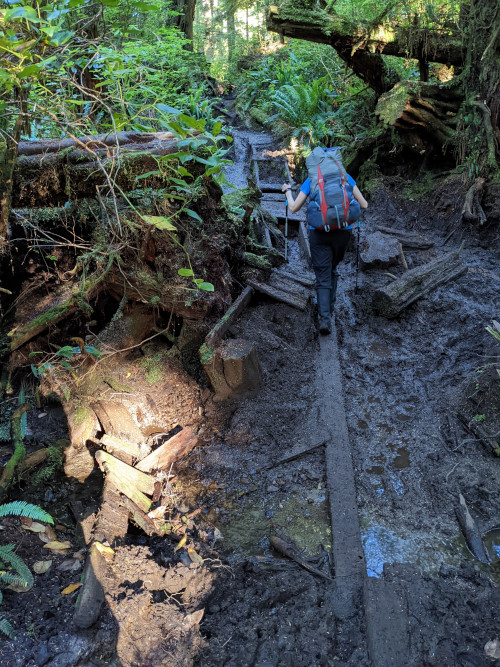
Not So Nice Boardwalk

Cable Cars Are Fun
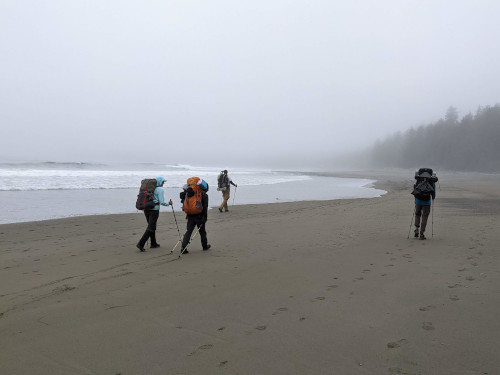
Easy Beach Walks
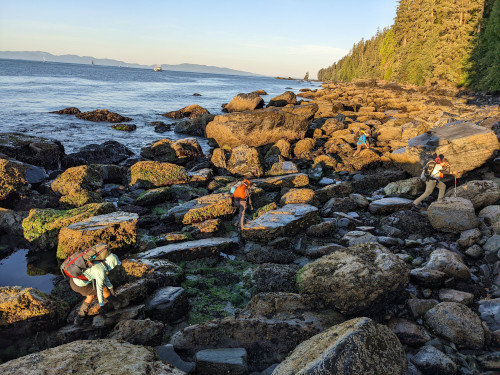
Not So Easy Rock Scrambles
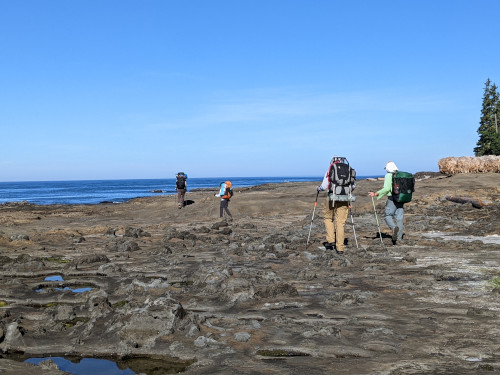
The Trail was Flat...
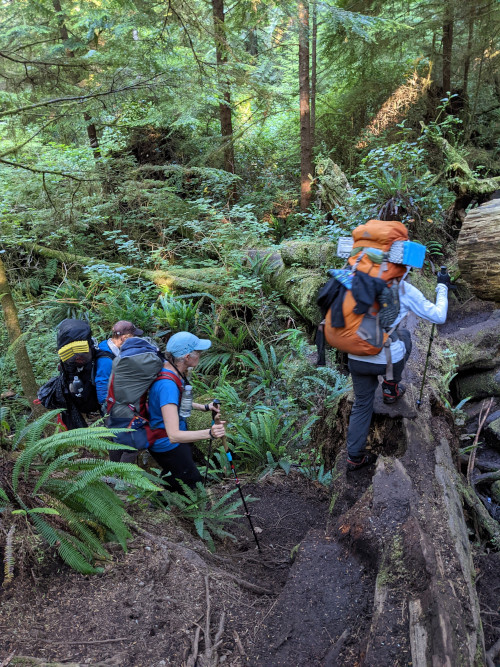
And Not So Flat
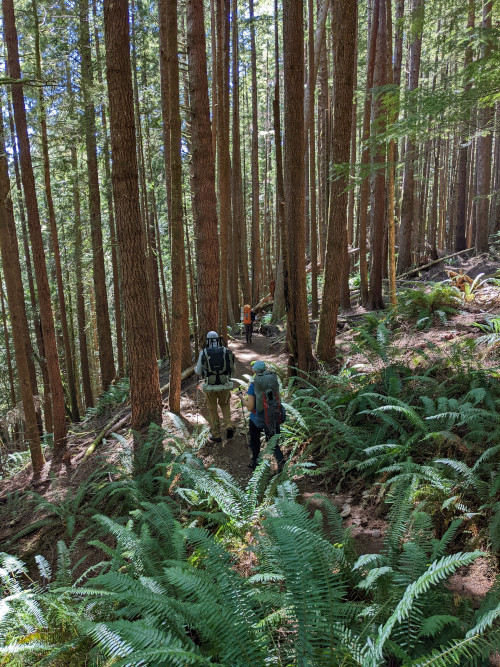
Beautiful Forest...
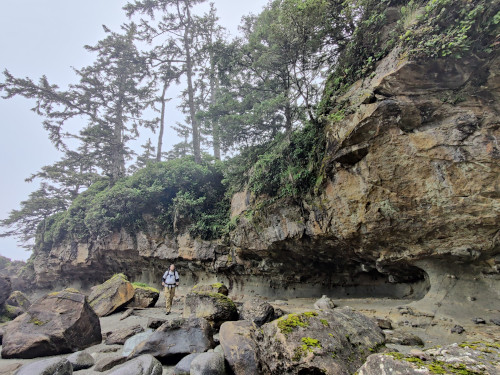
and Coastline
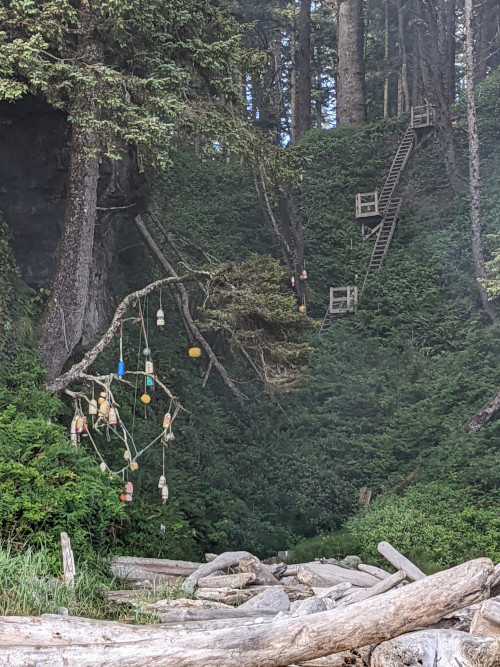
Buoys hanging in trees marked the trail into the higher forest...
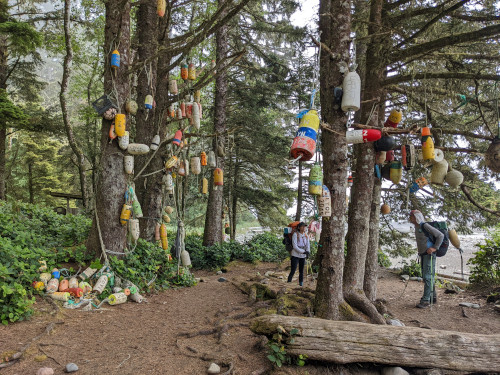
Or, they were just buoys in trees.
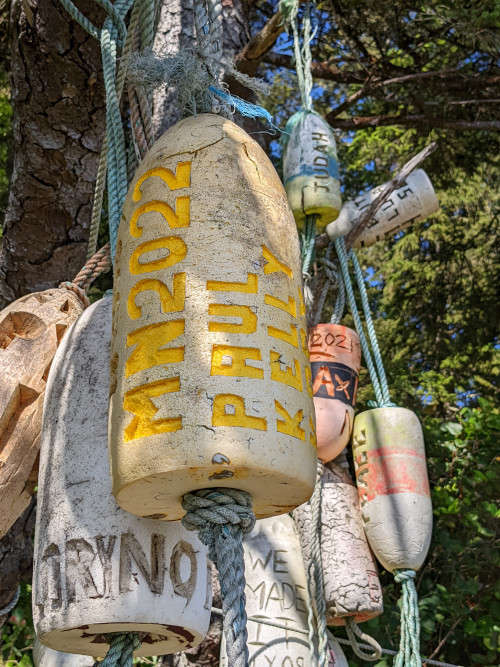
So, we added one found on the beach.
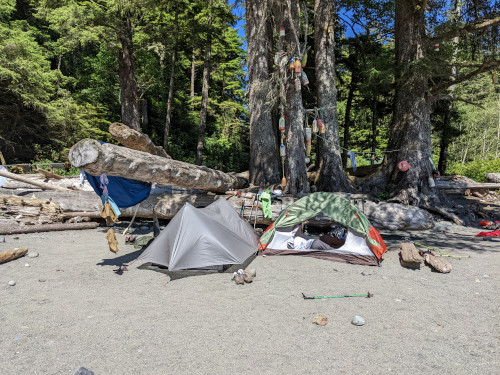
All the campsites were very nice.

So were the toilets at each camp.
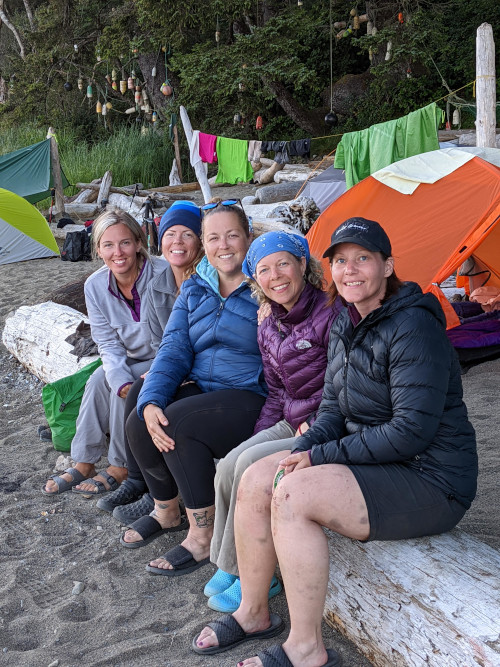
We made some friends.
And enjoyed so many things along the way...
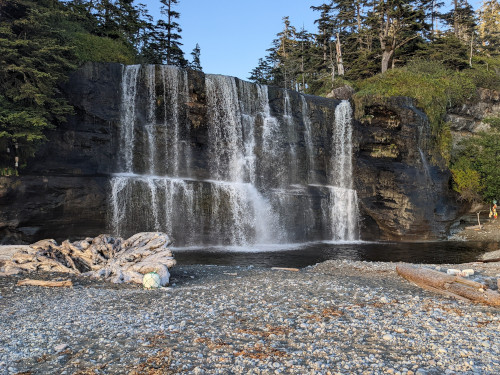
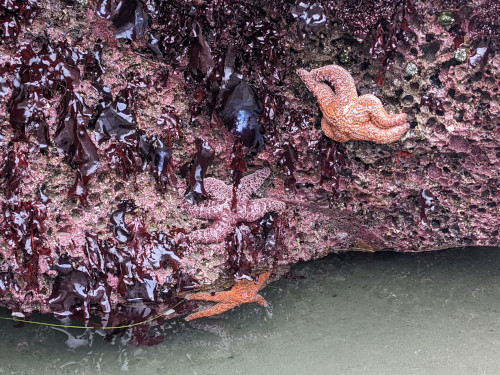
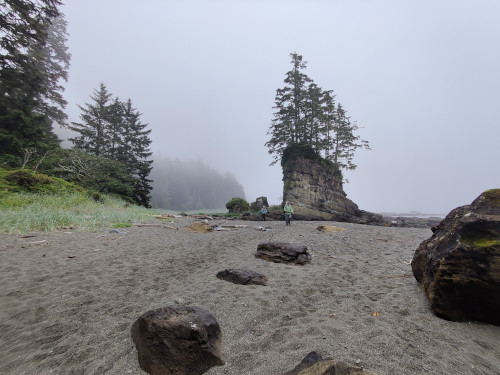

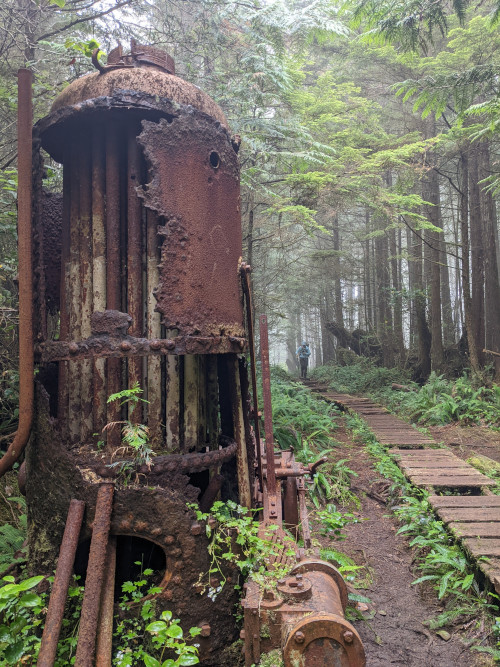
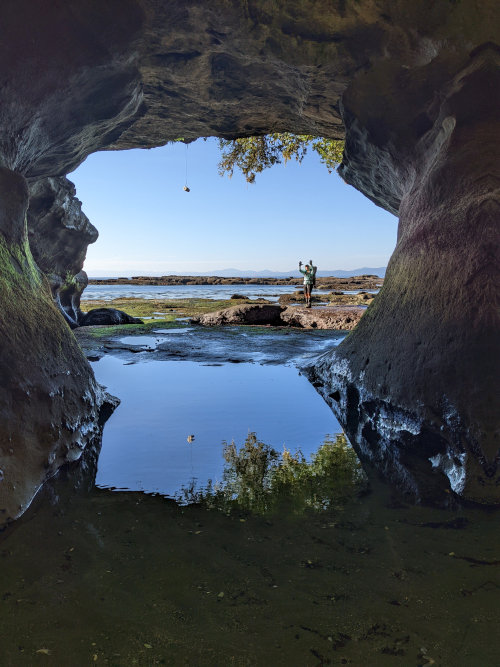
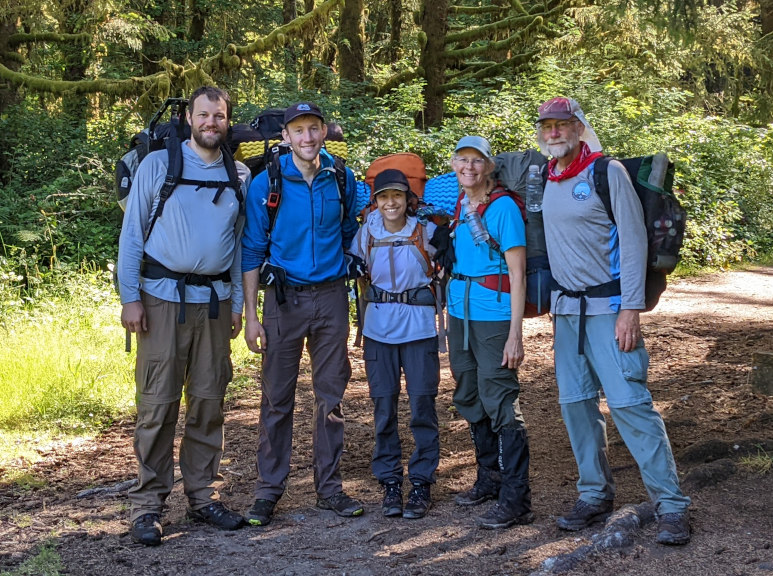
Until We Reached the End
Posted: 08/03/2022
08/18/2022

My long hike of the Pacific Northwest Trail was the most isolated, as we met only a handful of other hikers over 1,000 miles. The West Coast Trail is definitely NOT isolated in that way! Of all the trails I've hiked, the WCT easily had us encountering the most hikers each day, even more than the Appalachian Trail.
Not many people actually hike long distances. The 2,200-mile Appalachian Trail only sees around 4,000 hikers attempting thru hikes each year, and the 1,200-mile PNT has more like 70 annual thru hike attempts. The 50-mile WCT gets from 5,000 to 7,000 thru hikers each year. So, from a hiker per mile per day perspective, the WCT is VERY CROWDED!
On any given day during the hiking season, there will be up to 25 people starting from both the north and south ends, and 20 from the middle going north or south. The day you start, there will be about 30 people starting to hike towards you. 30 people started the day before, and 30 the day before that. So, you should expect to cross paths with about 30 people each day, and that is about what we experienced.
We met a group of 8 men, a family of 5, many couples and threesomes, and a few solo hikers - all going in the opposite direction. It seemed that we always met them either in the middle of a muddy bog, or halfway up or down a series of ladders. Of course, this makes sense since these are choke points that take extra time and effort to get past.
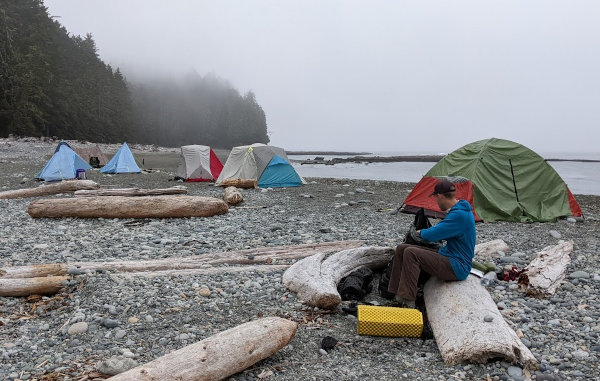
Even more so than on-the-trail, you'll notice the people at campsites. Since nights are spent at designated sites on the beach, those 30 people fill up the areas with a couple dozen tents. When you're used to plopping your tent down on any flat spot out in the wilderness, this is a big change.
We tended to start hiking early in the morning which meant we were often one of the first groups to arrive at campsites. Rather than taking a prime spot with easy access to the bear boxes, outhouses, water source, and trailhead, we set our shelters up far away from where we envisioned the majority of others would like to camp. This is just trail etiquette to allow those that may of had a hard day hiking to find a nice place.
We also preferred to be apart from the noise and activity around the many campfires that were built each night. For the most part, it worked out well, but I expect we would not win any 'life of the party' award.
Of the 100+ people we interacted with on the trail, there were none that were anything but friendly and considerate. Maybe it's a Canadian thing, but I got no 'entitled', 'weird', or 'sketchy' vibes that sometime crop up on other popular trails. We did meet a few folks that made the trek special...
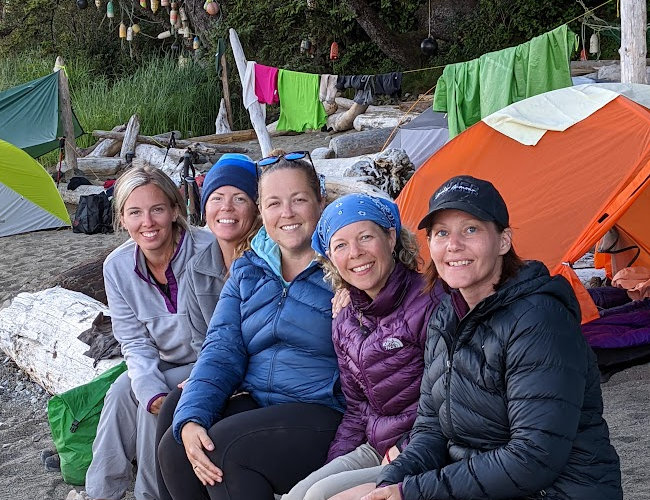
The ladies above (Erin, Candice, Amanda, Shannon, Ericka) followed the same itinerary as us. They did not all hike together through the day, but every afternoon or evening they eventually arrived at camp. Over the days, it was enjoyable to hear about their adventures, including getting lost, bushwhacking, and falling in mud. Pretty much every other obstacle you may hear about this trail seemed to happen to one or another of them at some point, but they persevered and fared as well as most.
One hiking pair that rode the shuttle bus with us was a father and young son. They were excited to hike, but after our boat ride with them across the Gordon River, we never saw them again. We got word on the second day that the dad had a boot blow out on the first day so they had to turn around and leave - hopefully, he fixed it and did a reboot (get it?).
Others from that original group would leap frog with us over the next days. One Canadian fellow had hiked the trail a couple times and shared a lot of information from his past experiences.

Upon reaching the northern terminus early in the day, we were greeted by a Trail Guardian, someone that maintains the trail, helps hikers, and shares local culture. My wife asked him if he'd take our group photo which he eagerly did, and surreptitiously got a couple of himself in as well. This is Kevin, whom I later learned is pretty well-known on the trail since he's been working on it for over 23 years now.
This year, Kevin has been sharing salmon with hikers that arrive at the terminus on Thursday afternoons - we missed it. He is also part of a crew responsible for the northern 25KM of the trail - there are 3 such crews, breaking the trail into three 25KM sections. It was a joy to chat with him for quite some time while he sharpened his chainsaw.
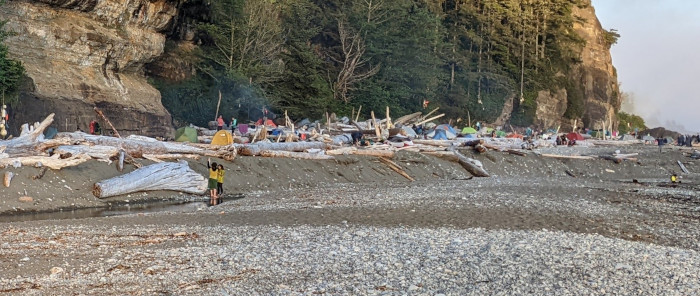
There were more women than men hiking the WCT during our time on trail. The last person we met on trail was at about kilometer 3, and she was a spitfire just heading south all by herself. All smiles, enthusiasm, and energy, with a small, light gear setup. I have no doubt she cruised down to the Gordon River without a care.
I noticed the diversity of hikers, too, and it was refreshing. On the long trails I've hiked, the typical hiker is a lean white male. The WCT is exceptionally different from that with a wide range of skin colors, body sizes, ages, and even languages. I heard English, French, Japanese, and Spanish (I think).
It seemed to me that the general 'vibe' on the WCT is more easy going than on longer trails. There was not a drive to cover many miles. Taking time to experience the widely ranging trail conditions and varying scenery was a nice luxury. Having a few hours to lounge around after hiking a few miles each day gave it more the feel of camping than hiking. I suppose the shorter trail length and commitment of just a week rather than a month or more had a lot to do with this.
I'll share what our camp life was like on the WCT in a couple days...
08/30/2022
Not long after leaving the crabshack on the ferry boat across the Nitinat Narrow to continue our northbound hike up the West Coast Trail, Kelly slipped on a very muddy uphill step. She landed right on a hiking pole and SNAP! the carbon fiber shattered.
Not long before that, I had slipped on a root and my ankle landed on my aluminum pole, bending it so it would not longer collapse. So, aluminum poles bend and fiber poles break.
Between Tsusiat Falls and Michigan Creek campsites, the West Coast Trail crosses the Kanawa River. This is a proper river with plenty of depth, width, and current - not like a little creek you can wade through. Fortunately, it also has a wonderful cable car to carry hikers across.
We sent two of us across with packs, then a 3rd with two packs, then Kelly and I with our 3 hiking poles and the last pack (and her broken one stashed away in the pack). It all went well until the very end.
This video shows our crossing...
Open video in Separate View
So, aluminum poles sink and fiber poles float.
Things like this happen all the time on the trail. We found (and carried out) broken poles, tips, and baskets, a shoe, clothing, and quite a lot of other dropped things, but very little trash like wrapper pieces on the trail. Some people might just leave the 'lost' items in the river, but that doesn't seem right and we really needed the poles to put up our tarp tent.
You can read more about our Kanawa crossing and our whole hike in my West Coast Trail Journal.
But, seriously, I prefer aluminum hiking poles over carbon fiber, and here's why:
- Aluminum is much less expensive (like $20 vs $100).
- Aluminum can take much more abuse before breaking, and has a longer lifespan of rough use.
- Bent aluminum can often be bent back to use a bit longer.
- Aluminum is not as sensitive to extreme cold and heat - especially becoming brittle in extreme cold.
- Aluminum can be recycled if the pole does become unusable.
If you decide to give hiking poles a try, take some time to learn to use them before going on a long hike. Some things to consider:
- Use the wriststrap correctly. Put your hand in from the bottom so your hand encircles both the wriststrap and the grip. This saves a lot of hand and wrist fatigue.
- Remove rubber tip guards and baskets. This reduces weight and prevents them from being lost on trail - I've lost count of the tips I've found along the way.
- Figure out your cadence between feet and poles. Typically, the pole on the left should touch the ground forward at about the same time as the right foot.
Hike On!
Posted: 08/30/2022
09/08/2022

More Miles = More Smiles is typically how a long hike goes. As long as there's daylight, the feet are moving and the next beautiful view is anticipated ahead on the trail. There is very little time spent sitting around a campsite - basically make dinner and head to bed for an early start on the next day.
As I mentioned earlier, the West Coast Trail is not a typical long distance trail. At only about 50 miles, it's a bit longer than most backpacking trips, but much shorter than most long trails (which tend to be at least hundreds of miles). This means, unless you are fastpacking or trying for an FKT, you tend to have shorter hiking days and more time in camp.

I'd like to share what our In Camp time was like on our trip, and hope it provides some insight and ideas for you planning a future West Coast Trail hike.

With a 5 kilometer hike from Gordon River to Thrasher Cove on our first day, even with a very late 11:15am start time after our mandatory orientation, we got to camp before 4:30pm. This would actually be our latest camp arrival time for the whole trip. Being in the 2nd group of 10 people ferried across the river, the campsite was already fairly crowded when we arrived even though we passed a few groups on the way. The photo above is of our first setup and it shows most of the important parts of our camp life.
Our Shelters - We had three different shelter styles. One person slept in a bivy sack with a silnylon tarp above him to keep off the heavy morning dew. Another two had a stand-alone tent with poles and rain fly. My wife and I had a tarp with a bug nest underneath.
All three shelters worked just fine, but a few things about them:
- the bivy takes up very little space and can be laid down between logs or rocks, or anyplace you can find.
- dome tents with poles can be pitched anywhere and really need no stakes, so sand is no problem.
- a tarp that requires separate poles needs stakes which can be a nuisance in soft sand. There were always drift logs or rocks available to help with the guylines, so it was not a problem.
- Morning dew was heavy many days. Having a rag, sponge, or bandana to sop most of the water off your shelter is a good idea.

Our Water - When I thru-hiked the Arizona Trail, finding enough water was an ongoing concern. The West Coast Trail has water everywhere! Since the trail follows the shoreline of Vancouver Island, hikers are constantly crossing small streams carrying water down from the small mountain range to the ocean. I never carried more than my single .6 liter bottle full of water, and every campsite is situated on a major river or creek.
We used two Sawyer Squeeze filters to treat all our water and they worked very well. At each camp, someone would take our three 2-liter dirty water bags to the water source, fill them, and carry them back to our campsite. Then, anyone that wanted water could attach the Squeeze filter to a bag and fill their water bottle from that. We would use the rest for dinner.
After dinner, someone would repeat the water source trip to get water for the next morning. By filling water bottles at night, while you have free time, the water can cool off more in the cold air overnight and time is saved in the morning.
Typically, we'd have a water refill and rest break once during the morning at some stream we passed. All the water sources were fine, but we were probably overly cautious at one...

At Walbran Creek, the historic water source seems to be a trickling waterfall on the east side of the creek a few hundred yards upstream from the camping area. Unfortunately, there has been a landslide there blocking access to the source. So, most people were just gathering water out of the lagoon that you can see in the background above. You can also see someone standing in the water just behind us. People were swimming, bathing, washing dishes, and I presume peeing in that water. So, we gathered all our water bottles into a large mesh bag along with our water filter and headed farther upstream. When we hit the landslide blockage, we swam across to the other side. About a quarter mile farther upstream, the lagoon ended and the stream had riffles and obvious flowage so we gathered our water there. Working our way back downstream with about 20 pounds of water over very slippery underwater rocks was quite an adventure, but at least we got good, clean water.
Also, at Tsusiat Falls camp area, I'd recommend getting water directly from the falls rather than from the outflow of the pool below it since many people bathe there. But, if no one has been in the water for some time, like early in the morning, I suppose any crud as been washed downstream.

Our Food - We really enjoyed how well our dinners worked out! We kepy things Super Simple!
Earlier this summer, on a backpacking trip in Wyoming, my buddy had made his own freeze-dried meals and they looked great. So, we purchased dried ingredients from Mother Earth Products (the best buys we could find online) and put together our own. Actually, my wife did pretty much all of it. She also purchased a tiny, inexpensive vacuum sealer and reusable bags. She added all the ingredients for one meal to a bag, closed it, and vacuumed the air out - presto! just like those $$$$ meals.
Our meals were:
- Chicken Tater Trasherole - chicken, mashed potatoes, hash browns, milk, onion, garlic, ranch dip
- Health Bowl - rice, lentils, almonds, cranberries, vegetable bouillon
- Pesto Veggie Pasta - ramen noodles, TVP, mushrooms, pesto mix, parmesan cheese, mixed vegetables
- Lentil Chili (my FAV!) - lentils, tvp, corn, peas, chili seasoning
- Adobo Chicken - chicken, rice, bouillon, garlic, pepper, soy sauce, vinegar
- Chicken Curry Rice - chicken, rice, raisins, apples, onion, curry, allspice, cinnamon, toasted nuts
The only cooking was boiling water and adding it to the individual bags.
Each person could choose which meal sounded good to them each night.
Clean up was just pouring a bit of hot water into the food bag, swishing it around, and drinking it. We took all the bags home and have washed them out to use on our next hike (we leave in a week).
We had simple non-cook food for breakfast, lunch, and snacks - cocoa, coffee, protein bars, granola bars, home-dried fruit, sausage and crackers, Austin-brand cracker sandwiches, M&Ms, trail mix, and the ever-popular Sour Patch Kids.
One super food item that I'd highly recommend is Pringles in a cardboard can (not a plastic can)! Here's why:
- Pringles are calorie dense at 150 cal/oz.
- They taste great with all that salt and crunch.
- They don't get crushed in a backpack.
- It's easy to share a can. We ate a can each day between the five of us.
- Put the lid on an empty can and squeeze the can quickly - it POPs the lid off for endless entertainment.
- The can makes an awesome garbage can when empty. You can pack wrappers and trash in it and it Will Not Break. I packed all my trash for the six days into a can and had room left.

In the photo above, you can see our cooking set up. The constant wind on the ocean meant we used wind blocks to save fuel. We had two canister stoves just so we would have boiling water for everyone at the same time - one stove would have been fine. You also might notice a Mountain House meal - one of us picked that up in a hiker box at the Crab Shack on Nitinat Narrows, so check there for free food when you hike through.

Once hot water was added to the meal pouches, we closed them and set them into individual Cozies that I made from insulating wrap. In less than 15 minutes, they were ready to eat and still very hot. These cozies are simple, cheap, and easy to make.

House Rules - If you are used to wild camping in the wilderness, or established camping in a park, the West Coast Trail has a few unique characteristics that puts it somewhere between the two. Reading the official paraphernalia from Parcs Canada will give you all the rules and guidelines, but some of the things I noticed were:
- Food Storage - We had a bear walk onto the beach out of the forest about 20 yards from our tent. Many other campers reported bear sightings. For this valid reason, every campsite has a group of bear containers in which campers should store their food, garbage, and smellables over night. The cans get packed full, so your crackers will probably get crushed. We also saw tracks of smaller rodents often on the beaches, and many mornings showed tiny mouse tracks completely covering every inch of wet sand in our camping area.
- Beach Camping - When you are right on the ocean's edge, things work a bit differently than inland...
- Tides - make sure your campsite is high enough that the incoming tide doesn't reach you. The high tide line is usually easy to see since the sand above it is covered with debris.
- Sand Bugs - There were no mosquitoes, flies, or ticks, but the sand is filled with tiny insects eating the washed up plant life. We got no bites from them, but maybe?
- Wet Sand - The sand at many camps is very fine and soft. When dry, it feels nice, but it gets into any crack, crevice, or open zipper. When wet, like from dew every morning, it sticks to everything. So, step carefully and wipe off lower legs and feet before going to bed and putting on shoes. And, keep things closed up and covered.
- Shelters - I mentioned before that you'll need to figure some way to anchor your tent using rocks or driftwood.
- Night Life - There are dozens of people packed into small sections of beach every night so courtesy is important.
- Campfires - I'm not used to having campfires, but there were a handful up and down the beach. Most areas were denuded of small driftwood for fires and people walked a long distance to scavenge wood. The brochures instructed to keep fires below the high tide line, but that rarely happened. Some beaches were covered in chunks of blackened wood and coal bits.
- Noise - The sounds of the ocean drown out most camper noise, but it's still nice to quiet down when the sun sets. We only had one instance of youth playing loudly next to our tents while we were trying to get to sleep and it didn't last long.
- Sleeping - I typically get up during the night when camping, but I slept straight through every night on the WCT. So, I didn't get to see any stars or night scenery. I think the soft sand makes for a very comfortable bed.
- Sewer - The guidelines say to bathe and wash dishes in the ocean or river mouths emptying into it. In other words, the ocean is the sewer out here. This is atypical to most Leave No Trace principles, but I guess dilution is a solution to pollution. Every evening, we walked down to the ocean edge to brush our teeth and spit into the waves. It was kinda fun. Fortunately, we had no dishes to wash with our meals.
- Toilets - No need to dig catholes on the West Coast Trail! The campsites have composting toilets - with yet more ladders to climb. You climb up, go inside, close the door, do your business, and then toss a handful of wood chips down the hole. That last part is important to make them work!
Since so many people all use the same door handle and ladders, washing your hands and using some alcohol sanitizer afterward is a very good idea.
It's ok to just swing by a campsite and use the toilet during the day, too.


Free Time - Being 2 hours behind our normal time, we woke up pretty early and were on the trail between 6 and 7 each morning. Some of this was also because we had to match the tides to do all the beach hiking we could. This meant we arrived at most camps around 1pm with our latest time being 4:20pm. All the free time is unusual for a long distance hiker since daylight is normally used for hiking.
We got to explore pretty much all the area around the camps. The tide pools and creeks were interesting, and the view out over the ocean was always changing. We saw some whales, otters, boats, and birds.
I spent a little time carving a buoy that was found on the beach and left at Michigan Creek. I also balanced a few long logs across other logs just for something to pass the time. Setting up camp, drying clothes, making meals, and resting took up the rest of the time.
Read the day-by-day of our adventure in my West Coast Trail Journal
Posted: 09/08/2022
09/20/2022
I find the few days right before a backpacking trip to be very exciting. Trying to make sure I have everything I really need, but not extra weight I don't need on this trip. Wondering if I really have enough food, or if I should add another handful of Sour Patch Kids. Checking that I can actually access the maps I think I downloaded to my phone even when it's in airplane mode. And, on and on.
Tomorrow, we'll be Up North to hike our 100 miles on the North Country Trail for 2022 and get a patch! We're going to hike the Border Route Trail from the west trailhead on Gunflint Trail road to the east trailhead on Otter Lake Road. This hike is about 65 miles and just happens to end right where the Superior Hiking Trail starts. Isn't that convenient?
Instead of stopping there, we're going to hike about another 50 miles down the SHT to Grand Marais, MN. That way, we can hop in our car and drive home at whatever time on whatever day we happen to finish without needing a shuttle at the end.
Most of the first 4 days will be in the Boundary Waters wilderness with no phone coverage, but I'll have my Spot along. If you'd like to make sure we're still moving, check out this real-time map - I hope it works. Once we hit the SHT, I might be able to drop a note now and then, but we'll see.We were planning on doing this last week, but starting into a 100% chance of rain for 2 days seemed kind of silly. The forecast is looking much better now and the fall colors should be well under way. And, there's a group of people I know doing a SHT thru-hike NorthBound that will be close to Grand Marais when we get there. If things fall into place, we might find them on trail to say 'Hi'.
Our packs with 10 days of food and expected temps right down to freezing are just about 30 pounds so I'm excited to start eating some of that weight off. When we finish, I'll tell you more about the new dinner meals we've been making and enjoying this season. So far, they've been most excellent!
Posted: 09/20/2022
09/22/2022
Posted: 09/22/2022
09/28/2022
Posted: 09/28/2022
10/07/2022
Anyway, it was a great trip with a lot of solitude in the first half and lots of people the second half.
Please read my Border Route Trail Info page, or jump right to the BRT Journal page.
Hike On!
Posted: 10/07/2022
Older Posts Newer Posts
Find more Hiking Resources at www.HikingDude.com


Follow Me
Recent Comments